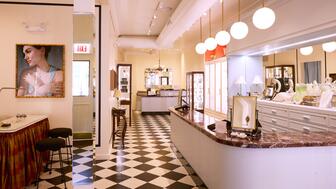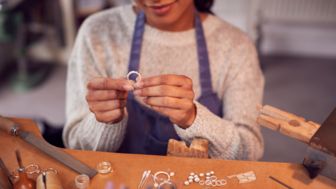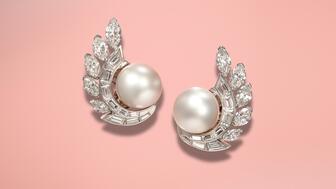Interior designer Athena Calderone looked to decor from the 1920s and 1930s when crafting her first fine jewelry collection.
The History Behind … eye miniatures
In this new monthly feature, National Jeweler editors delve into the when, where and why of antique jewelry. August’s focus is on eye miniatures, which first became popular in the 1770s.

New York--People generally have one of two reactions when they see an eye miniature staring back at them.
“People either love them or think they are just beautiful, or people think they are creepy,” says Cathy Gordon, an antique jewelry collector and a co-author of Miriam Haskell Jewelry. “People will see them and say, ‘That is very strange.’”
Eye miniatures first began appearing in artists’ logbooks in the 1770s and retained their popularity for nearly 100 years.
In this second installment of The History Behind … , National Jeweler explores the when, where and why of eye miniatures with Gordon, who supports her antique jewelry collecting “habit” by working at Google.
What are eye miniatures? Members of the upper class, first in France then in the U.K., commissioned artists to paint portraits of a loved one’s eye only and had them set into brooches, pendants or rings, sometimes surrounded by gemstones.
Eye miniatures also were put onto toothpick cases and patch boxes (when eye miniatures were popular, many members of the upper class carried small decals with them, which sometimes were used to hide smallpox scars), Gordon says.
These pieces also are known as miniature eye portraits or “Lover’s Eye” jewelry, though Gordon notes the latter is a misnomer, as these portraits weren’t always necessarily of one’s lover. They could depict the eye of a family member or someone else close to the wearer.
When were they popular? The earliest eye miniatures recorded in artists’ log books surfaced in the 1770s and their popularity continued until the 1850s, ceasing as photography became more widespread and the public’s fascination with these eye-only paintings began to wane. “It was a fad, to some extent,” Gordon says.
She adds that the eye miniature did enjoy a very brief revival during the Arts and Crafts movement (about 1880 to 1930), as she has a miniature of a man’s eye dated 1903 in her collection.
Why did people wear eye miniatures? Part of the broader category of sentimental jewelry, the wealthy wore eye miniatures to emphasize friendships or alliances, ease the absence of a loved one who was far away and serve as a reminder of those who had died.
Eye miniature mourning pieces are recognizable by engraved and dated inscriptions; the eye surrounded by clouds (signifying a passage into heaven) or by black or white enamel; symbols of mourning
What materials were used for these pieces? Here’s where eye miniatures pose a problem for collectors today: they typically were painted on either velum or Asian elephant ivory.
Because of federal ban on the commercial trade of elephant ivory, Gordon says it is extremely difficult to import eye miniatures painted on ivory into the United States today, even when there is appropriate certification and engraved dates on the piece proving it is an antique.
(According to the Jewelers Vigilance Committee, pieces that existed in the U.S. prior to the ban, which took effect in April, may be sold across state lines except in New York and New Jersey, which have banned the sale of elephant ivory. Under these state laws, antiques comprised of less than 20 percent elephant ivory can be sold but it requires the proper permit and proof of provenance.)
Pearls were the most commonly used stone for eye miniatures. Garnets and amethysts also were popular, as were coral and turquoise. Diamonds were used but rarely, Gordon says.
How much are eye miniatures worth? Retail prices range from $2,500 for a more simple miniature to $10,000 for pieces that have more sophisticated portraits and/or more gemstones.
How can a retailer add eye miniatures to their antique jewelry offerings? Given the complex laws surrounding ivory and the existence of fakes, Gordon gives advice for retailers that is good to follow across all product categories: find a trusted supplier.
Two Gordon recommends are Lenore Dailey and The Three Graces.
“There are many, many fakes out there,” she cautions.
She says some are portraits that have been generated on very high-quality, modern printers while others were cut out from full-sized portraits and remounted falsely as eye miniatures. One word of advice: if there’s a nose, it’s an indication that it’s probably not a genuine miniature but, rather, was part of a larger portrait at one time.
The History Behind … is a new monthly feature for National Jeweler that aims to educate readers on antique jewelry. The September feature will focus on Georgian-era mourning jewelry.
The Latest

During a call about its full-year results, CEO Efraim Grinberg discussed how the company is approaching the uncertainty surrounding tariffs.

The free program provides educational content for jewelry salespeople and enthusiasts to learn or refresh their diamond knowledge.

The feedback will be used to prepare other jewelers for the challenges ahead, the organization said.


The online sessions are designed to teach jewelers to use AI tools like ChatGPT and Claude to grow their business.

The opening marks the jewelry retailer’s first location in the Midwest.

Bench jewelers spend years honing their skills, Jewelers of America’s Certification validates their talents.

The “United in Love” collection offers tangible mementos of hearts entwined with traditional and non-traditional commitment heirlooms.

Robert Goodman Jewelers will hold a “Black Jewelry Designers and Makers” event on April 27.

The announcements follow a tumultuous start to 2025 for WJA, which saw a wave of resignations following controversial statements about DEI.

Editor-in-Chief Michelle Graff answers questions about how the new taxes levied on countries like India and China will impact the industry.

Kenewendo, Botswana’s minster of minerals and energy, discusses closing the deal with De Beers and the work that was missed along the way.

The historic fancy vivid blue diamond set to headline Christie’s Geneva sale next month could sell for up to $50 million.

LVMH CFO Cécile Cabanis also discussed the effects of tariffs so far.

The “Mad Men” and “The Morning Show” star steals jewelry, art, and handbags from his wealthy neighbors in “Your Friends & Neighbors.”

The organization has reelected Kalpesh Jhaveri as president.

An investigation found that the former managing director of Movado’s Dubai branch overstated and prematurely recorded sales.

The collection pays tribute to the Japanese philosophy of Ma, studying balance, stillness, and the interplay between presence and absence.

Mari Lou’s Fine Jewelry in Orland Park, a suburb of Chicago, is closing its doors.

GIA’s labs in Dubai and Hong Kong are now accepting larger diamonds in light of the “logistical challenges” presented by the new tariffs.

These earrings by Van Cleef & Arpels, featuring the same design as a pair worn by Princess Grace, are up for auction at Woolley & Wallis.

Two experts share how artificial intelligence tools can help retailers run a more efficient business.

Kentaro Nishimura, who has been with the pearl company since 1997, has been promoted to president and CEO of Mikimoto America.

“America Telling Time: 150 Years of Bulova” explores the storied history of the American watchmaker.

An across-the-board tariff of 10 percent remains in place for all U.S. trading partners, except China.

Brigette Pheloung and Tania Sarin, and their mothers, star in the campaign wearing medallions they co-designed.


























